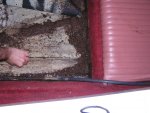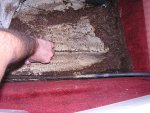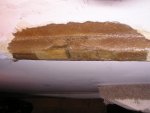Hey,
Thanks for reading. So I was in Lake Ontario on my 15FT 40hp runabout and the lake was pretty choppy. The boat has a very slight V (practically flat) and it hits the water VERY VERY hard as it bounces on the waves to the point that your *** simply hurts the next day - this and the fact that you can feel water at your feet in the back is when I realized my boat was pretty waterlogged. We were cruising and all was well until my friend in the back squealed that his foot was full of mud. I looked back and my heart dropped; I had a 10+ inch crack in the floor and the mud from between the layers was coming up as it hit the water. I did the only thing I could do and limped it back to shore and quickly launched.
Ladies and gentlemen, judging by the pictures, I have a few questions:
* Since I have successfully done two fiberglass repairs in the past from the outside, what is the least amount of work I can do to drain the water between the layers of the hull and patch this up such that it wouldn't happen anymore?
* How and why did this happen? Even if my boat was not waterlogged, wouldn't there be pressure from the bottom by the impact of hitting the water such that either the top or bottom would layer would break?
* If the only solution here (and I really hope its not) is to tear up the back floor, remove foam, put new positive-buoyancy type of material and reseal, then what else can I use besides foam? I ask this since I have seen countless of people on here complaining that because of a tiny hole in the hull, the entire floor needed to be removed and re-foamed. Basically, I'd rather use 2L (sarcastic) pop bottles filled with air than having to do that every time.
* What steps are required?
Thanks very much for reading.
Thanks for reading. So I was in Lake Ontario on my 15FT 40hp runabout and the lake was pretty choppy. The boat has a very slight V (practically flat) and it hits the water VERY VERY hard as it bounces on the waves to the point that your *** simply hurts the next day - this and the fact that you can feel water at your feet in the back is when I realized my boat was pretty waterlogged. We were cruising and all was well until my friend in the back squealed that his foot was full of mud. I looked back and my heart dropped; I had a 10+ inch crack in the floor and the mud from between the layers was coming up as it hit the water. I did the only thing I could do and limped it back to shore and quickly launched.
Ladies and gentlemen, judging by the pictures, I have a few questions:
* Since I have successfully done two fiberglass repairs in the past from the outside, what is the least amount of work I can do to drain the water between the layers of the hull and patch this up such that it wouldn't happen anymore?
* How and why did this happen? Even if my boat was not waterlogged, wouldn't there be pressure from the bottom by the impact of hitting the water such that either the top or bottom would layer would break?
* If the only solution here (and I really hope its not) is to tear up the back floor, remove foam, put new positive-buoyancy type of material and reseal, then what else can I use besides foam? I ask this since I have seen countless of people on here complaining that because of a tiny hole in the hull, the entire floor needed to be removed and re-foamed. Basically, I'd rather use 2L (sarcastic) pop bottles filled with air than having to do that every time.
* What steps are required?
Thanks very much for reading.























